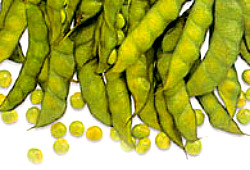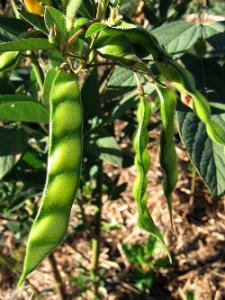 Pigeon pea (Cajanus cajan) is a perennial member of the family Fabaceae. The fruits are pods, containing four to five seeds. The seeds can be a range of colours: light brown, but they can be cream, grey, purple or black, depending on the variety. Pigeon peas are both a food crop (dried peas, flour, or green vegetable peas) and a forage/cover crop. The flavor of pigeon peas is often described as nutty, like a rich grain. They contain high levels of potassium, phosphorus, magnesium and calcium. It has good amount of iron and selenium and small amount of zinc, copper and manganese. Pigeon Pea has good amount of Vitamin A, Niacin and small amount of thiamine, riboflavin, Vitamin B6, folate and pantothenic acid. It is considered an environmentally beneficial plant as it can enrich soil. Although it can grow in any warm climate, the pigeon pea is particularly popular throughout tropical regions.
Pigeon pea (Cajanus cajan) is a perennial member of the family Fabaceae. The fruits are pods, containing four to five seeds. The seeds can be a range of colours: light brown, but they can be cream, grey, purple or black, depending on the variety. Pigeon peas are both a food crop (dried peas, flour, or green vegetable peas) and a forage/cover crop. The flavor of pigeon peas is often described as nutty, like a rich grain. They contain high levels of potassium, phosphorus, magnesium and calcium. It has good amount of iron and selenium and small amount of zinc, copper and manganese. Pigeon Pea has good amount of Vitamin A, Niacin and small amount of thiamine, riboflavin, Vitamin B6, folate and pantothenic acid. It is considered an environmentally beneficial plant as it can enrich soil. Although it can grow in any warm climate, the pigeon pea is particularly popular throughout tropical regions.
Pigeon peas are easy to grow, provided you live in an area with abundant sun and little frost. They tolerate most soils and can survive with limited water, although they perform better with heartier environments. The plant is somewhat short lived, usually lasting about 5 years.
Pigeon pea better known as “kadios” here in the Philippines, is a minor crop that is usually grown in backyards or some insignificant portion of the farm. Actually, however, it is one crop that has a big potential, both for small-scale and large-scale production. Pigeon pea is not only a vegetable crop but also for other agricultural purposes. It is a super crop for dryland agriculture because it is an excellent animal feed aside from being a protein-rich human food. It is also useful in increasing soil fertility, in preventing soil erosion, and in suppressing weeds in upland farms. Of course, the main reason why pigeon pea should be produced by more farmers is its importance as nutritious food. Young pods as well as mature fresh are cooked in dishes together with other vegetables.
It is fortunate that a Filipino is the head of ICRISAT that is based in India where research studies on pigeon pea and other crops for drylands are conducted. A new high-yielding varieties have been introduced in the Philippines. A local program has been started to promote the production of this crop. After testing several introduced hybrid varieties, they have observed two to be highly suitable for Philippine conditions. One is called ICP7035 which is a perennial plant, meaning it will stay productive for several years. It produces a lot of fruiting branches resulting in high yields. The fruits come in bunches.
The other hybrid that grows well in the country is ICP88039. This bears fruits throughout the year as it is not sensitive to the length of daylight. It is very resistant to drought because it is very deep-rooted. Seeds of these two recommended hybrid pigeon peas are now being multiplied for sale to other farmers from other parts of the country.
So far, there are no disease problems observed to attack pigeon pea in the Philippines. It has been observed, however, that when the plants start to flower, leaf-eating insects are prevalent. To prevent or control insect damage, the experts recommend a weekly spraying with insecticide like Decis, Lannate and others.
How to grow Pigeon Pea or Kadios
Benefits of Pigeon Pea
- Survive in poor soil conditions
- Tolerant of dry weather
- Nutritious and high-protein pulse crop
- Leaves can be used for animal feed
- The fast-growing plants make good shade for other crops, e. g. vegetables, herbs, vanilla Perennial for up to 5 years
- Woody parts can be used for firewood
- Water and nutrients from deep in the soil can be caught by its deep taproot
- Plants can be used along contour barriers for erosion control
- Helps in agro-ecology, performance of Pigeon Pea as an intercrop is remarkable and even after the harvesting of the intercrop it continues protecting the soil.
Climate
Pigeon pea has a reputation for drought resistance. Although the plant can survive in very dry conditions, experience indicates that seed yield is minimal under these conditions. Flowering is delayed under periods of extreme moisture stress. However, rainfall to alleviate such a stress will stimulate further flowering. The principles of summer crop agronomy developed for sunflowers and sorghum are relevant to pigeon pea production. On the northwest plains, 0.75 to 1.0 m of wet soil is a prerequisite for planting. Pigeon peas are sensitive to frost, which will defoliate the plant.
Soils
The crop can be grown on a wide range of soil types from lighter loams to the clay soils of the plains. Good surface and internal drainage is essential, as short periods of waterlogging will kill the plant, especially in the younger stages. Because of the susceptibility of the crop to waterlogging, furrow irrigation during growth is not currently recommended, except in very well drained situations A furrow irrigation program would normally involve pre-irrigating and planting into a full profile of soil moisture. Spray irrigation on well drained soils is feasible.
Planting times
The limitation to early planting appears to be a requirement for a minimum soil temperature of 18ºC at sowing depth at 9 a.m. ESST. Pigeon pea characteristically grows slowly and competes poorly with weeds, and low soil temperatures will lengthen the establishment phase. The recommended planting time is from late November to early January. December is considered the best month to plant in normal seasons. This is especially the case on the slopes, where crops could be frosted before maturity if planted in January. As a guide, the crop takes about 65 to 80 days to flower and a further 50 to 75 days for the pods to mature.
Plant Populations and Row Spacings
Under dryland conditions in north-west NSW, populations of 100 000 to 200 000 established plants/ha are preferred. The higher population would be desirable in better rainfall areas and with at least 1 m of subsoil moisture. In drier areas, and with less than 1 m of stored moisture, the desired plant population is lower. Seed size of well filled seed of the variety Quest is about 12 to 15 g/100 seeds, although seed grown under harsh conditions may be lighter. Wide row spacings of 70 cm to 1 m are suitable for this crop under dryland conditions, enabling inter-row cultivation when necessary. However, under irrigation, at least 300 000 plants/ha should be established in rows less than 40 cm apart. Growers have described pigeon peas as easier to establish than sunflowers. Sowing depths of up to 5 cm have proven satisfactory. The use of press wheels with light pressure has improved emergence.
Inoculum
Pigeon peas require inoculation with the Group J inoculant. Nodules can be difficult to find in high nitrogen soils, but the plant should nodulate quite freely in low nitrogen soils. Nodulation can be erratic on alkaline black clay soils.
Fertilizer
On phosphorus-deficient soils, apply phosphate fertilizer at the rates recommended for sunflowers. Zinc deficiency may occur on alkaline clay soils. Application of foliar zinc in this situation will result in a quick response. Soil applications can overcome zinc deficiency for 5 years and longer. Pigeon pea hosts VAM fungi, allowing the crop to gain access to phosphorus and zinc in the soil and fertilizer.
Weed Control
As mentioned previously, pigeon pea grows slowly as a seedling, and as such is a poor competitor with weeds. There are a number of herbicides available for grass and broadleaf weed control. Inter-row cultivation can be used successfully when the crop is sown in wide rows.
Insects
Heliothis is the major pest of pigeon pea, and can completely devastate a crop if not correctly managed. Regular crop checking should begin as soon as the first flowers appear. Checking should be carried out two or three times a week during flowering. Eggs are laid in and around flowers, so you should time the spraying to control the hatching larvae. The importance of adequate checking and insect control cannot be overstated for two reasons:
- The crop is attractive to heliothis, which can substantially decrease yields.
- The strategy to overcome the insecticide resistance problem in the summer-cropping belt of northern NSW depends on the astute and responsible use of the insecticides now available. Compliance with the strategy restrictions on the use of pyrethroids and the proper timing of applications of other chemicals is essential to maintain the efficacy of these compounds. Other insect pests that can cause problems are cutworms at the establishment stage and grass blue butterfly during the vegetative stage (first 4 weeks), particularly when crops are moisture stressed. Thrips, mirids, green vegetable bug and pod sucking bug can also damage crops during flowering and podding. Pigeon pea is resistant to root lesion nematode, and aids the build-up of beneficial VAM fungi in the soil.

Harvesting
The perennial nature of pigeon pea results in green leaves and often flowers being present on the plant when the older pods have matured and dried. Frosts will cause leaf drop and make harvesting easier. Grading may be required to remove residual green leaf material. Crops planted in December to January will generally be ready for harvest in May–June. Crops can be desiccated with defoliants, which will reduce the amount of green material that has to pass through the header. Crops will be ready for harvest some 10 to 12 days after application. The flowering and configuration of the plant mean that seed is well presented for harvest. Conventional open-front headers will successfully harvest the crop, although (as with most grain legumes) rotary harvesters are preferred. Slow drum speeds of 350 to 400 rpm are required to minimize seed cracking. The use of low-speed bat reels appears to cause less shattering, as the crop is swept back from the cutter bar. Separator sieve and wind settings should be similar to those used for soybean harvesting. Mature pods are quite tolerant of weather damage.
Yields
Yields of up to 3 t/ha have been recorded under very favorable seasonal conditions. Yields under normal conditions should be between about 0.5 and 2 t/ha.
Marketing
India is the main destination for pigeon peas, although smaller markets exist where Indians have settled in other countries. Seed is usually sold as the dry split pea (dhal) for human consumption. The marketing of pigeon pea will probably follow the pattern set by the chickpea industry, which has an entirely free market. Some growers choose to grow at least part of their crops under contract, whereas others wait until harvest to find an outlet for their product. Pigeon peas contain tannin and trypsin inhibitors in the seed. Heat treatment by cooking removes the trypsin, but you should take care if you intend to feed unprocessed pigeon peas to livestock. Pigeon pea protein levels are usually around 20 per cent.
Sources: Wikipedia.org, agribusinessweek.com, dpi.nsw.gov.au; Photos: bar.gov.ph, permacultureliving.com.au
I would like to buy atleast initial amount of the seeds in order for us to propagate here in the Philippines..where can l order?